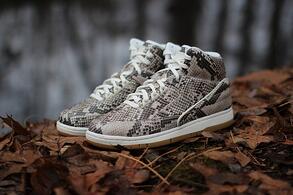 High-end clients have high-end requirements. To satisfy the sneaker needs of pickier clientele, your product has to be unquestionably top-notch. First off, you have to look for an exclusive material without overriding the desired properties of good footwear. The product also has to have a reasonable balance between uniqueness, flexibility, and durability.
High-end clients have high-end requirements. To satisfy the sneaker needs of pickier clientele, your product has to be unquestionably top-notch. First off, you have to look for an exclusive material without overriding the desired properties of good footwear. The product also has to have a reasonable balance between uniqueness, flexibility, and durability.
You have to look for an unsurpassable hide to satisfy the market's demand for such exotic shoes. A good example of an ideal material for making a vogue pair of sneakers is the python skin.
Why Python Skin?
Using python leather plays out well for both the shoemaker and the sneakerhead. Here are some reasons why python skin makes great sneakers.
1: Softness and Suppleness
Python skin is soft and highly elastic. Footwear manufacturers have an easy time cutting the leather and stitching the panels together. The end product is a soft and light pair of shoes which is very comfortable to the feet. A well-designed pair of python sneakers keeps the feet pampered all day long.
2: Large Working Area
Python skin used for sneakers can be up to 3.5 meters long and 30 centimeters wide. Such a wide area allows designers to make complete pairs of shoes from the same skin, as well as making matching scales and patterns an easy process. You can cut multiple sizeable panels from a single skin.
Since the skin is linearly aligned and evenly shaped, you can effortlessly make the most appropriate cuts for your job to reduce waste. For an average pair of sneakers, one Grade II skin of about 25 cm by 28 cm should complete the project. If you need to make larger size shoes, 30 cm or more of Grade I leather should suffice.
Python skins that come from farms usually have minimal blemishes. Hence, it is easy to find large Grade I leather on the market. Using python skin, therefore, spares you the daunting job of concealing and avoiding flaws.
3: Distinctive Appearance
All python skins are naturally eye-catching, and it is easy to single them out from other types of leather. They come in various colors and with many decorative features, such as net-like patterns and rounded color forms.
Their variation allows you to make impressive sneaker designs with a high degree of authenticity. The leather usually comes with unique black marks which are highly recognizable if left intact. The center scales of python skin are distinctive and they provide an exclusive exotic look.
4: Moderately Priced
Python skin is one of the most wallet-friendly skins in the exotic leather market. It is more widely available than crocodile or alligator skin, while also offering extra benefits which are hard to achieve with croc skin and its cousins.
Python skin is easy to work with due to its suppleness, yet the demand for its end products competes significantly with higher priced exotic leathers. This raw material is ideal for any shoe manufacturer or sneakerhead since it combines style and value for money.

Tips for Selecting Python Leather
Choosing the appropriate piece of leather requires some insight. These are some key factors you should always look out for when selecting the skin.
Front Cuts and Back Cuts
Most python skin distributors present skins in the form of front cuts and back cuts. The incisions which occur when skinning the python determine the cut to make. The belly scale of the front cut is more defined near the edges, whereas the back cut puts the wide belly-scales at the center. Some people refer to back cuts as belly skins.
Market demand also determines the cuts supplied. Back cuts are more popular than front cuts, and they dominate the high fashion industry due to their distinctive 3D-like appearance. However, this imbalance in demand is mostly a result of customer tastes and preferences and has little to do with skin quality.
Bleaching
Bleaching gets rid of the diamond effect of the skin as well as other markings. Both bleached and unbleached types of leather are equally available. The decision to work with marked or bleached skin depends on the final product’s desired level of sophistication and design aesthetic.
Finish
The skin can assume various finishes such as glazed, matte, suede, and metallic. The final look also depends on customer preference.
Pricing
The cost primarily relies on the usable area of the leather and its quality. The skin is available in different sizes depending on species and age of the python. Most dealers measure the breadth of the skin at its widest part. Grade I and II leathers produce the most exquisite sneakers.
Fashioning a pair of sneakers from an exotic skin will likely dent your pocket, but if you’re looking to balance affordability and extra edge, python skin should top your list.



